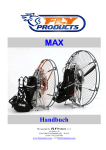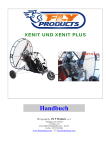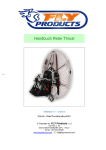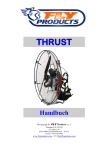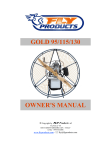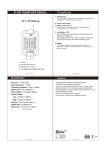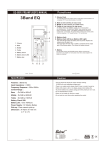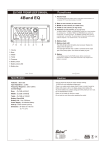Download A.S.C. BARS USER MANUAL
Transcript
A.S.C. BARS USER MANUAL VERSION 1.0 – 04/2014 FLY Products s.r.l. - Via Perù n. 30 63013 GROTTAMMARE (AP) - ITALY tel./fax +39.735.632486 www.flyproducts.com - [email protected] © Copyright by ASC BAR SETTINGS FOR PARAMOTORS WITH GEARBOX REDUCTION ACCORDING TO THE PILOT WEIGHT A = FOR PILOTS OVER TO 75 KG. (165 LB.) B = FOR PILOTS UP TO 75 KG. (165 LB.) ASC BAR SETTINGS FOR PARAMOTORS WITH BELT DRIVE REDUCTION ACCORDING TO THE PILOT WEIGHT A = FOR PILOTS OVER TO 75 KG. (165 LB.) B = FOR PILOTS UP TO 75 KG. (165 LB.) HANGING STRAP AND BACK-UP STRAP CONFIGURATION BACK-UP STRAP PAY CLOSE ATTENTION TO THE STRAPS POSITION S = shoulder extension webbing configuration D = ASC strap setting to limit the bars travel upward ( the "A" angle should be between 85 e 90 degrees ) B = loosly attach the harness to the frame allowing the harness to slide up and down RIGHT WRONG Adjust this strap to raise the harness seat plate to a parallel position between your body and the paramotor frame. Test this in standing and sitting position (simulator) VERIFY ALL YOUR SETTINGS ON A SIMULATOR PRIOR TO YOUR FIRST FLIGHT The paramotor thrust line angle with the engine OFF should be between 15 to 25 degrees The paramotor thrust line angle while flying should be between 0 to 5 degrees The harness back support length can be changed according to the pilot height using the zippers at the bottom to make it longer or shorter another way to adjust the back length is by changing the attachment plat position Using the belly strap This strap should be closed in flight to allow the ASC bars to work in parallel For big pilots , it is suggested to leave this strap open during take off and landing. ONCE AIRBORNE REMEMBER TO CLOSE IT AGAIN! Exit from the harness RIGHT POSITION TO LAND Extend your legs and push your chest forward. The harness seat plate will slide into position behind your body and the paramotor frame WRONG POSITION TO LAND










